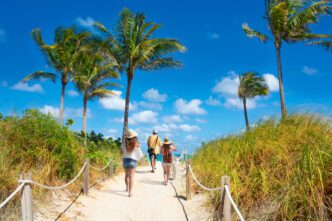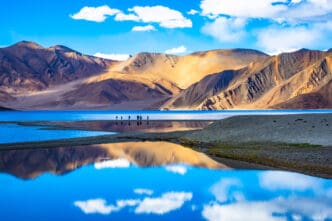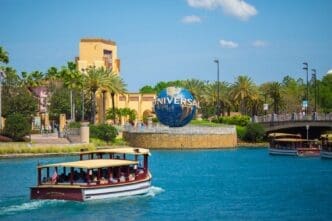For travelers dreaming of the perfect escape, Southeast Asia offers an embarrassment of riches, a seemingly endless collection of islands that define the very essence of paradise. From the dramatic limestone karsts of Thailand and the Philippines to the volcanic spirituality of Indonesia, these destinations cater to every type of adventurer—be it the sun-seeking luxury traveler, the intrepid backpacker, or the dedicated scuba diver. While the best time to visit varies by region due to monsoon seasons, the allure is constant: turquoise waters, powdery white-sand beaches, lush jungle interiors, and vibrant local cultures. This guide navigates the region’s most beautiful islands, revealing why this corner of the world remains an unparalleled magnet for those seeking beauty, adventure, and blissful relaxation.
The Philippine Archipelago: A Crown Jewel of Island Beauty
Comprising over 7,600 islands, the Philippines is a titan of tropical splendor. Its waters are a kaleidoscope of blues, and its landscapes are so surreal they often seem computer-generated. For many, this archipelago represents the pinnacle of island perfection.
Palawan: The Last Frontier
Frequently topping “world’s best island” lists, Palawan is a long, slender island that feels like a world apart. It’s often called the country’s “last ecological frontier,” and its raw, unspoiled beauty is breathtaking. The main hubs, El Nido and Coron, are the gateways to its most spectacular sights.
In El Nido, fleets of traditional bangkas (outrigger boats) ferry visitors through the Bacuit Archipelago. Here, towering black limestone cliffs rise vertically from the emerald water, hiding secret beaches and pristine lagoons. Tours of Big Lagoon and Small Lagoon are essential rites of passage, allowing you to kayak or swim in waters of impossible clarity.
Further north, Coron is a mecca for wreck divers, home to a fleet of Japanese supply ships sunk during World War II. But its beauty extends above the waves, most famously at Kayangan Lake. After a short, steep climb, you are rewarded with a panoramic viewpoint before descending to swim in the lake’s crystal-clear, brackish water, often cited as the cleanest in the Philippines.
Siargao: The Surfing Capital
Once a sleepy secret known only to die-hard surfers, Siargao has exploded in popularity, yet it retains its laid-back, bohemian charm. The island is famous for its legendary “Cloud 9” surf break, a powerful and hollow right-hand reef break that attracts professionals from around the globe.
Beyond the surf, Siargao enchants visitors with its vast coconut palm forests, natural rock pools, and hidden lagoons. A day trip to Sugba Lagoon offers a stunning enclosed waterway perfect for paddleboarding and diving from a wooden platform. The Magpupungko Rock Pools, accessible only at low tide, reveal a series of clear tidal pools perfect for a refreshing dip.
Boracay: The Resurrected Paradise
No list of Philippine islands is complete without Boracay. Famous for its four-kilometer stretch of White Beach, the sand here is so fine and white it feels like powdered sugar. For years, the island suffered from over-tourism, leading to a landmark six-month closure and rehabilitation in 2018.
Today, a reborn Boracay enforces stricter environmental regulations, resulting in cleaner beaches and a more sustainable approach to tourism. While the wild party scene has been toned down, the island’s natural beauty shines brighter than ever. It remains a premier destination for those who want stunning beaches, a wide range of water sports, and excellent hotels and restaurants, all in one easily accessible package.
Indonesia’s Volcanic Wonders and Spiritual Retreats
As the world’s largest archipelago with over 17,000 islands, Indonesia offers staggering diversity. From the deeply spiritual culture of Bali to the raw, untamed wilderness of its eastern islands, this nation is a universe of travel experiences unto itself.
Bali: The Island of the Gods
Bali is more than just an island; it’s a mood, a spiritual haven, and a cultural phenomenon. Its unique brand of Hinduism permeates every aspect of daily life, from the intricate canang sari offerings placed on sidewalks to the thousands of ornate temples dotting the landscape.
The island’s geography is incredibly varied. Ubud, in the central highlands, is its cultural heart, surrounded by terraced rice paddies and deep ravines. The southern coast is a surfer’s dream, with the legendary breaks of Uluwatu and the trendy beach clubs of Canggu and Seminyak. For tranquility, the north and east coasts offer black sand beaches and a slower pace of life.
The Gili Islands: A Trio of Escapes
Just off the coast of Lombok, east of Bali, lie the three Gili Islands. Each offers a distinct personality, but they share a common charm: no motorized vehicles are allowed. Transport is by bicycle or cidomo, a small horse-drawn cart, creating a wonderfully peaceful and slow-paced atmosphere.
Gili Trawangan (Gili T) is the largest and most developed, known for its vibrant nightlife and dive shops. Gili Meno, the smallest and quietest, is the quintessential honeymoon escape with secluded beaches. Gili Air strikes a perfect balance between the two, offering a relaxed vibe with plenty of great restaurants and yoga studios. All three islands are ringed by coral reefs, making it incredibly easy to snorkel with sea turtles just a few feet from the shore.
Raja Ampat: The Epicenter of Marine Biodiversity
For the truly adventurous and deep-pocketed traveler, Raja Ampat in West Papua is the ultimate prize. This remote archipelago sits at the heart of the Coral Triangle and boasts the highest recorded marine biodiversity on Earth. Its underwater world is a fantasyland of vibrant corals, massive schools of fish, and majestic manta rays.
Above water, the scenery is equally dramatic, characterized by hundreds of jungle-covered karst islands mushrooming out of the sea. The iconic viewpoint over the Wayag or Piaynemo island clusters is a sight that defines remote paradise. Getting here requires more time and resources, but for divers, photographers, and nature lovers, it is a pilgrimage worth making.
Thailand’s Iconic Isles: From Blockbusters to Barefoot Bliss
Thailand’s islands have been on the global travel map for decades, their names synonymous with tropical dreams. Split between the Andaman Sea on the west coast and the Gulf of Thailand on the east, they offer a huge range of experiences.
The Phi Phi Islands: A Cinematic Dream
Made world-famous by the 2000 film The Beach, the Phi Phi Islands are the poster child for Thai beauty. The archipelago is centered around two main islands: the uninhabited Phi Phi Leh and the larger, populated Phi Phi Don. Phi Phi Leh is home to Maya Bay, a breathtakingly beautiful cove enclosed by 100-meter-high cliffs.
After being closed for several years to allow its ecosystem to recover, Maya Bay has reopened with strict visitor limits and a ban on swimming, preserving its pristine state. Boat tours from Phi Phi Don or nearby Phuket and Krabi remain one of Southeast Asia’s most popular excursions.
Koh Samui & Neighbors: Gulf Coast Glamour
On the Gulf coast, Koh Samui is one of Thailand’s most developed and accessible islands, served by its own charming international airport. It offers a sophisticated blend of luxury resorts, world-class spas, and fine-dining restaurants, alongside beautiful beaches like Chaweng and Lamai.
A short ferry ride away is Koh Phangan, an island of two halves. It is infamous for the monthly Full Moon Party on Haad Rin beach, but the rest of the island is a tranquil sanctuary of yoga retreats, wellness centers, and quiet, beautiful bays. Nearby Koh Tao is a diver’s paradise, known as one of the world’s cheapest and most popular places to get a PADI scuba certification.
Lesser-Known Paradises in Vietnam and Malaysia
Beyond the headliners in Thailand and the Philippines, stunning islands await in neighboring countries, often offering a more tranquil and authentic experience.
Phu Quoc, Vietnam: An Emerging Star
Located in the Gulf of Thailand, just off the coast of Cambodia, Phu Quoc has rapidly transformed from a sleepy backwater into Vietnam’s premier island destination. The northern half of the island is a protected national park, while the southern coast is fringed with postcard-perfect beaches like Sao Beach, with its fine white sand and turquoise water.
Phu Quoc is also known for producing high-quality fish sauce and peppercorns. A visit to a pepper farm or fish sauce factory offers a fascinating cultural insight. The island is also home to the world’s longest over-sea cable car, which connects the main island to the smaller Pineapple Island, offering stunning aerial views of the An Thoi archipelago.
The Perhentian Islands, Malaysia: Unspoiled Marine Parks
On the east coast of Peninsular Malaysia, the Perhentian Islands are a classic backpacker favorite that has retained its rustic charm. The two main islands are Perhentian Kecil (Small) and Perhentian Besar (Big). Kecil is livelier with more budget-friendly options, while Besar is quieter and caters more to families and couples.
The real star here is the water. As part of a protected marine park, the snorkeling and diving are superb and easily accessible from shore. You can expect to see an abundance of coral, reef sharks, and sea turtles in the crystal-clear sea. It’s important to note that the islands are largely closed during the monsoon season, typically from November to February.
Planning Your Southeast Asian Island Adventure
Navigating this vast and varied region requires some planning, especially concerning weather and logistics.
When to Go: Navigating the Monsoons
Southeast Asia’s climate is dominated by wet and dry seasons, which occur at different times across the region. As a general rule, the Andaman Coast of Thailand and Malaysia (Phuket, Krabi, Perhentians) is best from November to April. The Gulf of Thailand (Koh Samui, Koh Phangan) has a different rainy season, making it a better choice from January to September.
The Philippines’ dry season generally runs from November to May, while Bali and the Gili Islands in Indonesia are best visited from April to October. Always research the specific microclimate of your chosen island before booking.
Responsible Tourism: Protecting Paradise
The immense popularity of these islands has put a strain on their fragile ecosystems. The temporary closures of Boracay and Maya Bay serve as powerful reminders of the importance of sustainable travel. As a visitor, you can make a positive impact by choosing eco-conscious tour operators, minimizing single-use plastics, respecting local customs, and supporting local communities by eating at family-run restaurants and buying authentic crafts.
By traveling thoughtfully, we can help ensure that these breathtakingly beautiful islands remain pristine for generations of adventurers to come.
Ultimately, the islands of Southeast Asia are more than just destinations; they are a vibrant tapestry of nature, culture, and adventure. Whether you are seeking the perfect wave, a serene spiritual retreat, or the simple joy of sand between your toes, this region holds an island that is waiting to become your personal paradise. The hardest part is simply choosing which one to visit first.








